Sociology Assignment: Edward Evans-Pritchard's Studies in Africa
VerifiedAdded on 2023/04/17
|9
|1788
|87
Essay
AI Summary
This essay provides an overview of Edward Evans-Pritchard's significant contributions to anthropology through his studies of the Azande and Nuer people in Africa. It explores his research on the Azande's beliefs in witchcraft, highlighting his perspective of cultural relativism and challenging colonialist views of the Azande culture. The essay also examines his work with the Nuer, focusing on their egalitarian social structure and resistance to British colonialism. Pritchard's emphasis on fieldwork, participant observation, and his ability to understand cultures from an insider's perspective are also discussed. The essay analyzes his methodologies, advantages of participant observation, and the challenges anthropologists face in the field. It concludes by emphasizing the importance of Pritchard's work in reshaping anthropological approaches and understanding diverse cultures, underscoring the value of objective observation and engagement within the communities studied.
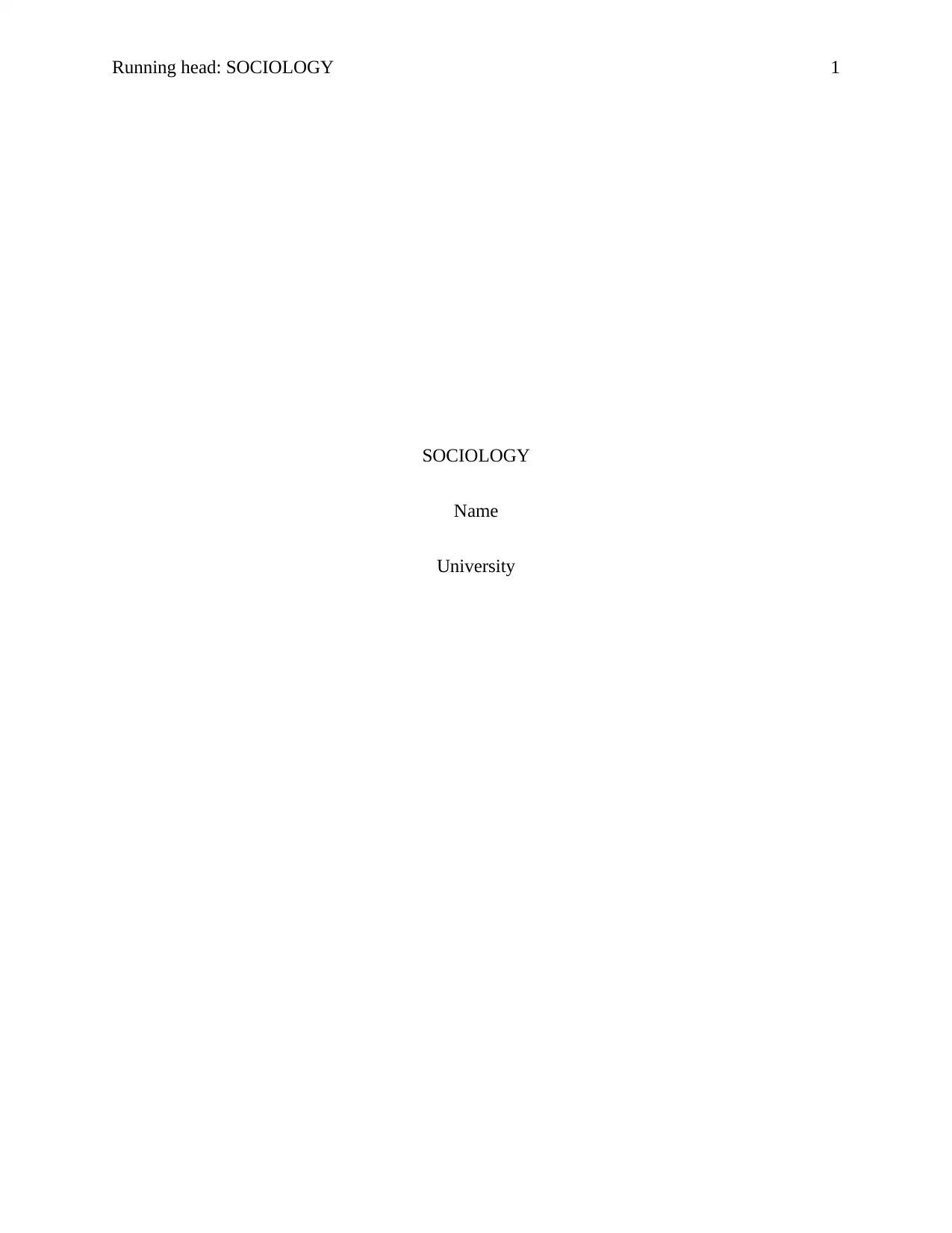
Running head: SOCIOLOGY 1
SOCIOLOGY
Name
University
SOCIOLOGY
Name
University
Paraphrase This Document
Need a fresh take? Get an instant paraphrase of this document with our AI Paraphraser
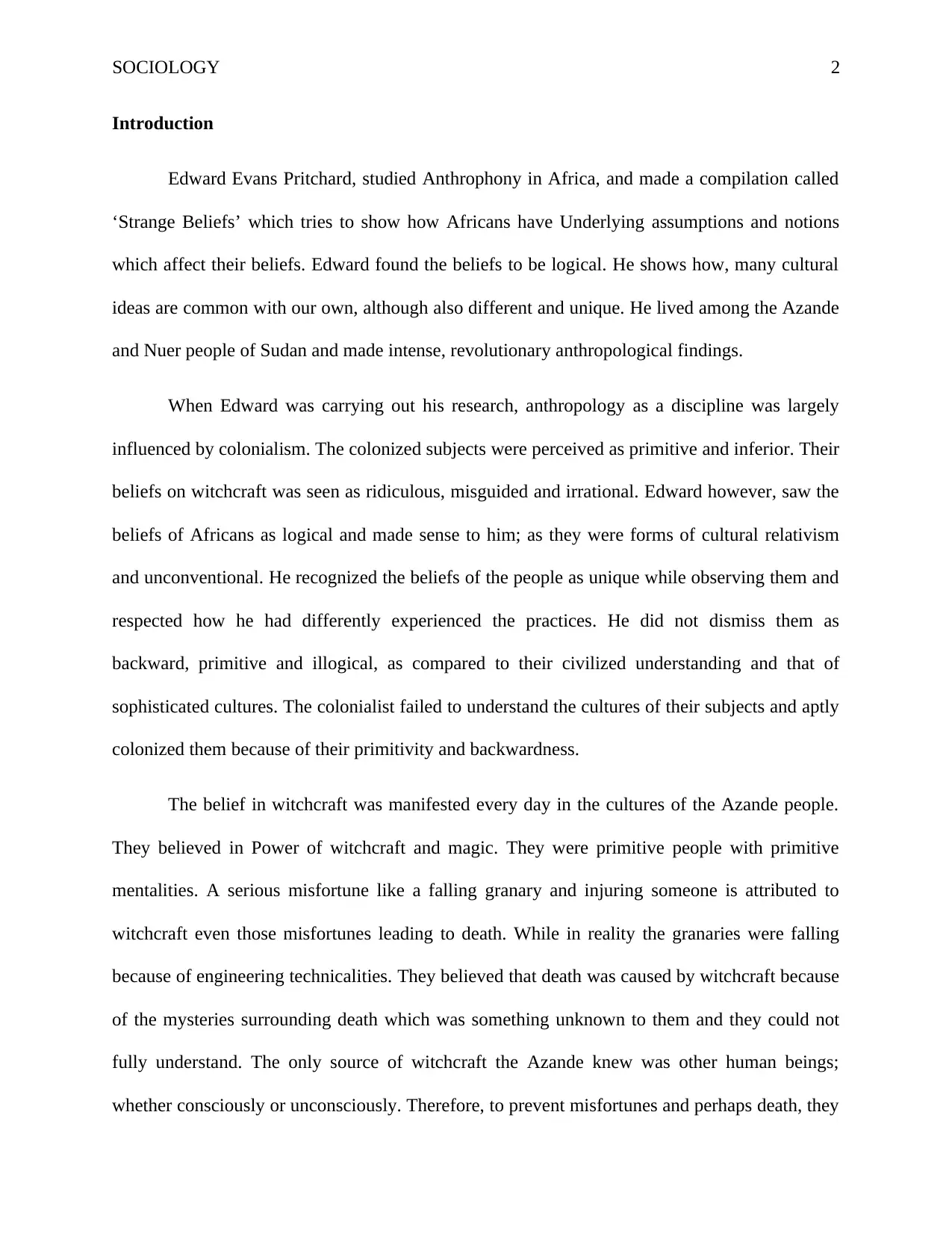
SOCIOLOGY 2
Introduction
Edward Evans Pritchard, studied Anthrophony in Africa, and made a compilation called
‘Strange Beliefs’ which tries to show how Africans have Underlying assumptions and notions
which affect their beliefs. Edward found the beliefs to be logical. He shows how, many cultural
ideas are common with our own, although also different and unique. He lived among the Azande
and Nuer people of Sudan and made intense, revolutionary anthropological findings.
When Edward was carrying out his research, anthropology as a discipline was largely
influenced by colonialism. The colonized subjects were perceived as primitive and inferior. Their
beliefs on witchcraft was seen as ridiculous, misguided and irrational. Edward however, saw the
beliefs of Africans as logical and made sense to him; as they were forms of cultural relativism
and unconventional. He recognized the beliefs of the people as unique while observing them and
respected how he had differently experienced the practices. He did not dismiss them as
backward, primitive and illogical, as compared to their civilized understanding and that of
sophisticated cultures. The colonialist failed to understand the cultures of their subjects and aptly
colonized them because of their primitivity and backwardness.
The belief in witchcraft was manifested every day in the cultures of the Azande people.
They believed in Power of witchcraft and magic. They were primitive people with primitive
mentalities. A serious misfortune like a falling granary and injuring someone is attributed to
witchcraft even those misfortunes leading to death. While in reality the granaries were falling
because of engineering technicalities. They believed that death was caused by witchcraft because
of the mysteries surrounding death which was something unknown to them and they could not
fully understand. The only source of witchcraft the Azande knew was other human beings;
whether consciously or unconsciously. Therefore, to prevent misfortunes and perhaps death, they
Introduction
Edward Evans Pritchard, studied Anthrophony in Africa, and made a compilation called
‘Strange Beliefs’ which tries to show how Africans have Underlying assumptions and notions
which affect their beliefs. Edward found the beliefs to be logical. He shows how, many cultural
ideas are common with our own, although also different and unique. He lived among the Azande
and Nuer people of Sudan and made intense, revolutionary anthropological findings.
When Edward was carrying out his research, anthropology as a discipline was largely
influenced by colonialism. The colonized subjects were perceived as primitive and inferior. Their
beliefs on witchcraft was seen as ridiculous, misguided and irrational. Edward however, saw the
beliefs of Africans as logical and made sense to him; as they were forms of cultural relativism
and unconventional. He recognized the beliefs of the people as unique while observing them and
respected how he had differently experienced the practices. He did not dismiss them as
backward, primitive and illogical, as compared to their civilized understanding and that of
sophisticated cultures. The colonialist failed to understand the cultures of their subjects and aptly
colonized them because of their primitivity and backwardness.
The belief in witchcraft was manifested every day in the cultures of the Azande people.
They believed in Power of witchcraft and magic. They were primitive people with primitive
mentalities. A serious misfortune like a falling granary and injuring someone is attributed to
witchcraft even those misfortunes leading to death. While in reality the granaries were falling
because of engineering technicalities. They believed that death was caused by witchcraft because
of the mysteries surrounding death which was something unknown to them and they could not
fully understand. The only source of witchcraft the Azande knew was other human beings;
whether consciously or unconsciously. Therefore, to prevent misfortunes and perhaps death, they
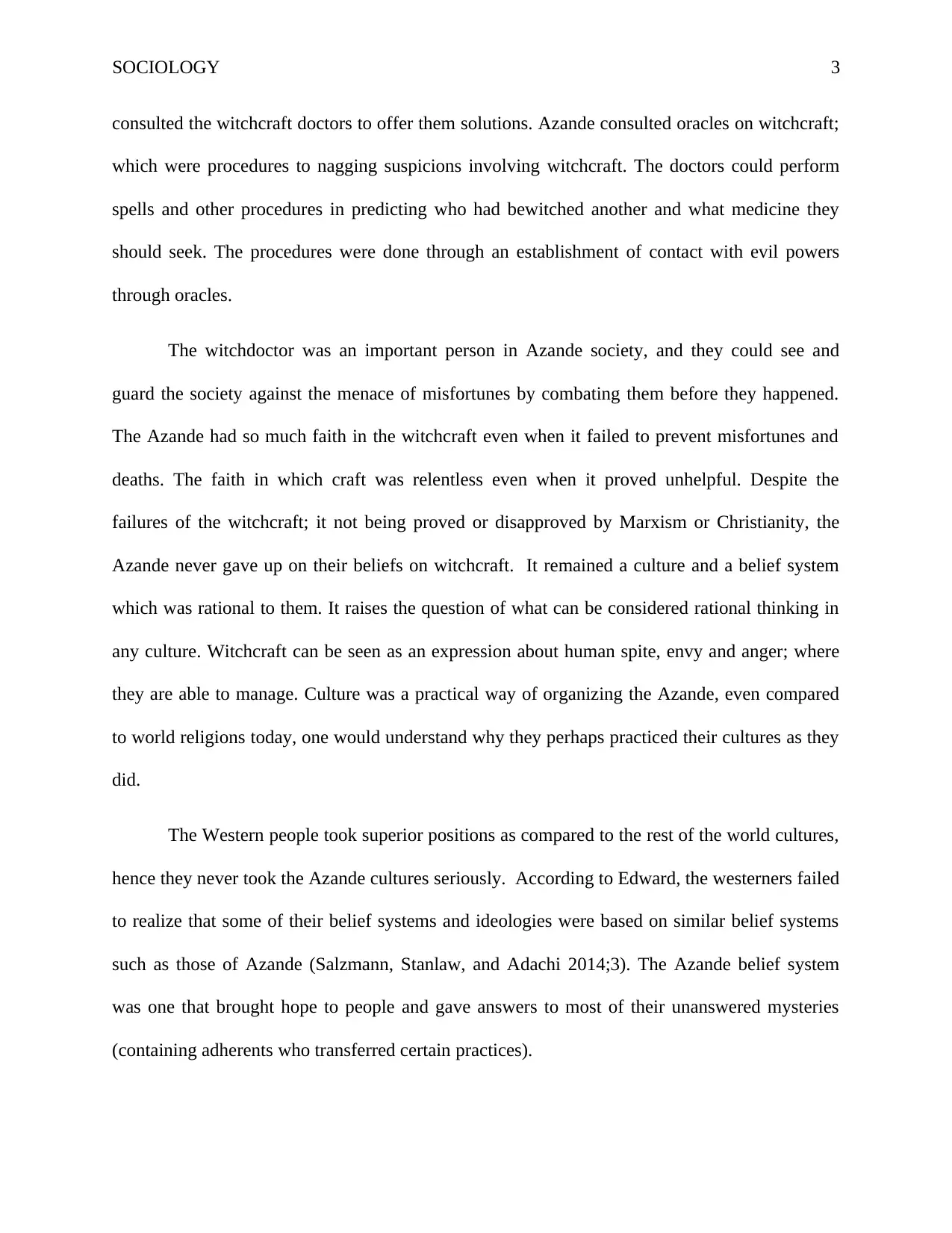
SOCIOLOGY 3
consulted the witchcraft doctors to offer them solutions. Azande consulted oracles on witchcraft;
which were procedures to nagging suspicions involving witchcraft. The doctors could perform
spells and other procedures in predicting who had bewitched another and what medicine they
should seek. The procedures were done through an establishment of contact with evil powers
through oracles.
The witchdoctor was an important person in Azande society, and they could see and
guard the society against the menace of misfortunes by combating them before they happened.
The Azande had so much faith in the witchcraft even when it failed to prevent misfortunes and
deaths. The faith in which craft was relentless even when it proved unhelpful. Despite the
failures of the witchcraft; it not being proved or disapproved by Marxism or Christianity, the
Azande never gave up on their beliefs on witchcraft. It remained a culture and a belief system
which was rational to them. It raises the question of what can be considered rational thinking in
any culture. Witchcraft can be seen as an expression about human spite, envy and anger; where
they are able to manage. Culture was a practical way of organizing the Azande, even compared
to world religions today, one would understand why they perhaps practiced their cultures as they
did.
The Western people took superior positions as compared to the rest of the world cultures,
hence they never took the Azande cultures seriously. According to Edward, the westerners failed
to realize that some of their belief systems and ideologies were based on similar belief systems
such as those of Azande (Salzmann, Stanlaw, and Adachi 2014;3). The Azande belief system
was one that brought hope to people and gave answers to most of their unanswered mysteries
(containing adherents who transferred certain practices).
consulted the witchcraft doctors to offer them solutions. Azande consulted oracles on witchcraft;
which were procedures to nagging suspicions involving witchcraft. The doctors could perform
spells and other procedures in predicting who had bewitched another and what medicine they
should seek. The procedures were done through an establishment of contact with evil powers
through oracles.
The witchdoctor was an important person in Azande society, and they could see and
guard the society against the menace of misfortunes by combating them before they happened.
The Azande had so much faith in the witchcraft even when it failed to prevent misfortunes and
deaths. The faith in which craft was relentless even when it proved unhelpful. Despite the
failures of the witchcraft; it not being proved or disapproved by Marxism or Christianity, the
Azande never gave up on their beliefs on witchcraft. It remained a culture and a belief system
which was rational to them. It raises the question of what can be considered rational thinking in
any culture. Witchcraft can be seen as an expression about human spite, envy and anger; where
they are able to manage. Culture was a practical way of organizing the Azande, even compared
to world religions today, one would understand why they perhaps practiced their cultures as they
did.
The Western people took superior positions as compared to the rest of the world cultures,
hence they never took the Azande cultures seriously. According to Edward, the westerners failed
to realize that some of their belief systems and ideologies were based on similar belief systems
such as those of Azande (Salzmann, Stanlaw, and Adachi 2014;3). The Azande belief system
was one that brought hope to people and gave answers to most of their unanswered mysteries
(containing adherents who transferred certain practices).
⊘ This is a preview!⊘
Do you want full access?
Subscribe today to unlock all pages.

Trusted by 1+ million students worldwide
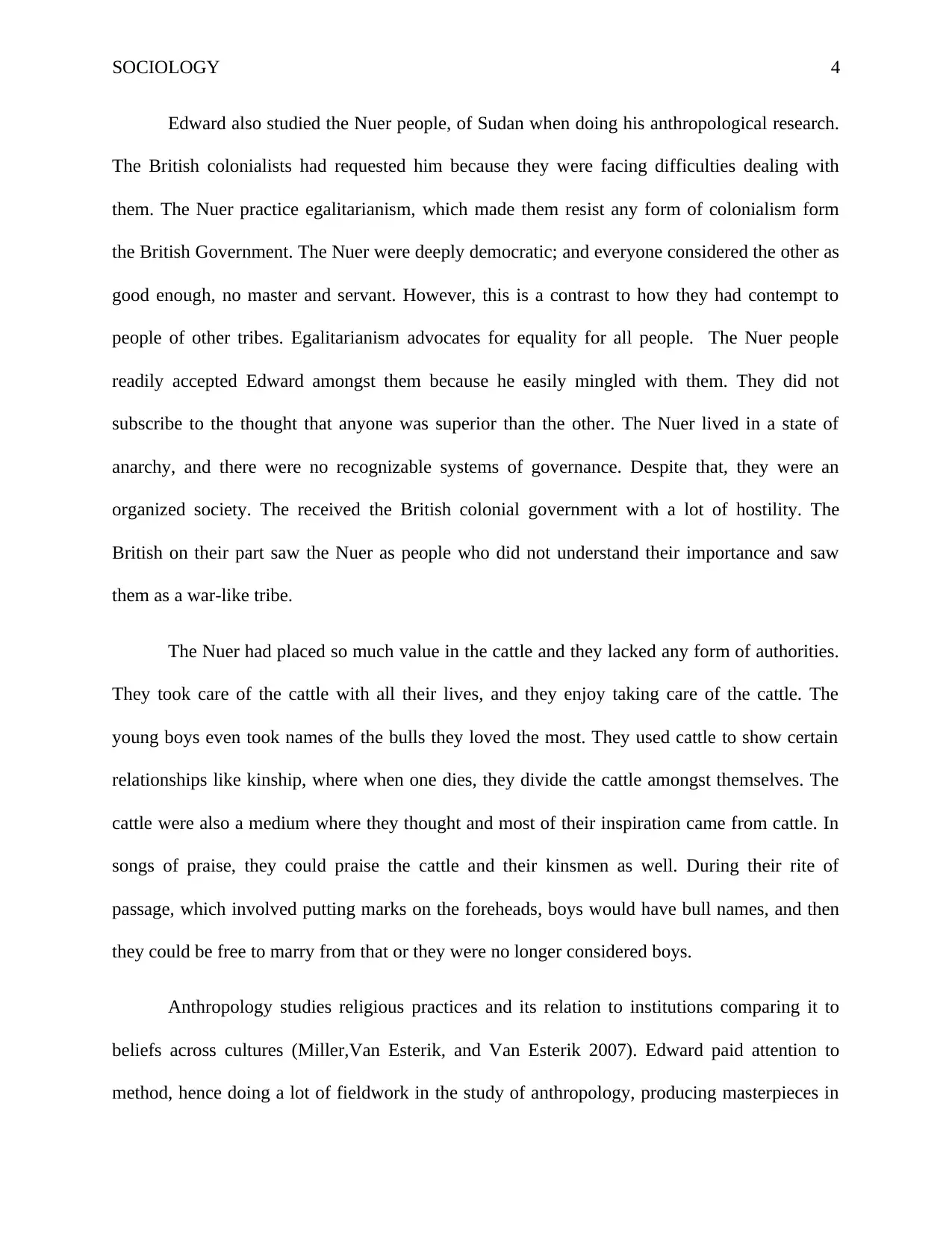
SOCIOLOGY 4
Edward also studied the Nuer people, of Sudan when doing his anthropological research.
The British colonialists had requested him because they were facing difficulties dealing with
them. The Nuer practice egalitarianism, which made them resist any form of colonialism form
the British Government. The Nuer were deeply democratic; and everyone considered the other as
good enough, no master and servant. However, this is a contrast to how they had contempt to
people of other tribes. Egalitarianism advocates for equality for all people. The Nuer people
readily accepted Edward amongst them because he easily mingled with them. They did not
subscribe to the thought that anyone was superior than the other. The Nuer lived in a state of
anarchy, and there were no recognizable systems of governance. Despite that, they were an
organized society. The received the British colonial government with a lot of hostility. The
British on their part saw the Nuer as people who did not understand their importance and saw
them as a war-like tribe.
The Nuer had placed so much value in the cattle and they lacked any form of authorities.
They took care of the cattle with all their lives, and they enjoy taking care of the cattle. The
young boys even took names of the bulls they loved the most. They used cattle to show certain
relationships like kinship, where when one dies, they divide the cattle amongst themselves. The
cattle were also a medium where they thought and most of their inspiration came from cattle. In
songs of praise, they could praise the cattle and their kinsmen as well. During their rite of
passage, which involved putting marks on the foreheads, boys would have bull names, and then
they could be free to marry from that or they were no longer considered boys.
Anthropology studies religious practices and its relation to institutions comparing it to
beliefs across cultures (Miller,Van Esterik, and Van Esterik 2007). Edward paid attention to
method, hence doing a lot of fieldwork in the study of anthropology, producing masterpieces in
Edward also studied the Nuer people, of Sudan when doing his anthropological research.
The British colonialists had requested him because they were facing difficulties dealing with
them. The Nuer practice egalitarianism, which made them resist any form of colonialism form
the British Government. The Nuer were deeply democratic; and everyone considered the other as
good enough, no master and servant. However, this is a contrast to how they had contempt to
people of other tribes. Egalitarianism advocates for equality for all people. The Nuer people
readily accepted Edward amongst them because he easily mingled with them. They did not
subscribe to the thought that anyone was superior than the other. The Nuer lived in a state of
anarchy, and there were no recognizable systems of governance. Despite that, they were an
organized society. The received the British colonial government with a lot of hostility. The
British on their part saw the Nuer as people who did not understand their importance and saw
them as a war-like tribe.
The Nuer had placed so much value in the cattle and they lacked any form of authorities.
They took care of the cattle with all their lives, and they enjoy taking care of the cattle. The
young boys even took names of the bulls they loved the most. They used cattle to show certain
relationships like kinship, where when one dies, they divide the cattle amongst themselves. The
cattle were also a medium where they thought and most of their inspiration came from cattle. In
songs of praise, they could praise the cattle and their kinsmen as well. During their rite of
passage, which involved putting marks on the foreheads, boys would have bull names, and then
they could be free to marry from that or they were no longer considered boys.
Anthropology studies religious practices and its relation to institutions comparing it to
beliefs across cultures (Miller,Van Esterik, and Van Esterik 2007). Edward paid attention to
method, hence doing a lot of fieldwork in the study of anthropology, producing masterpieces in
Paraphrase This Document
Need a fresh take? Get an instant paraphrase of this document with our AI Paraphraser
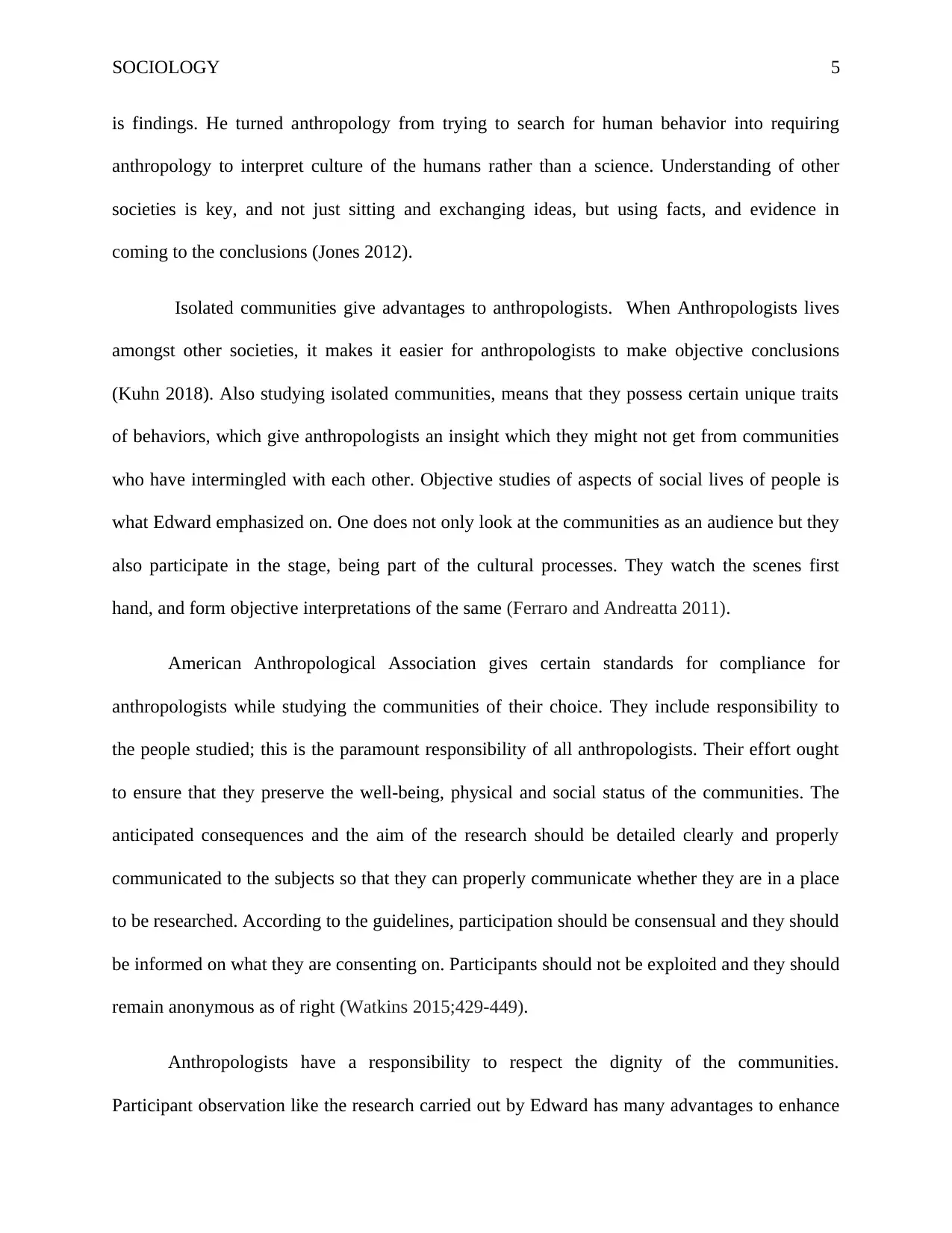
SOCIOLOGY 5
is findings. He turned anthropology from trying to search for human behavior into requiring
anthropology to interpret culture of the humans rather than a science. Understanding of other
societies is key, and not just sitting and exchanging ideas, but using facts, and evidence in
coming to the conclusions (Jones 2012).
Isolated communities give advantages to anthropologists. When Anthropologists lives
amongst other societies, it makes it easier for anthropologists to make objective conclusions
(Kuhn 2018). Also studying isolated communities, means that they possess certain unique traits
of behaviors, which give anthropologists an insight which they might not get from communities
who have intermingled with each other. Objective studies of aspects of social lives of people is
what Edward emphasized on. One does not only look at the communities as an audience but they
also participate in the stage, being part of the cultural processes. They watch the scenes first
hand, and form objective interpretations of the same (Ferraro and Andreatta 2011).
American Anthropological Association gives certain standards for compliance for
anthropologists while studying the communities of their choice. They include responsibility to
the people studied; this is the paramount responsibility of all anthropologists. Their effort ought
to ensure that they preserve the well-being, physical and social status of the communities. The
anticipated consequences and the aim of the research should be detailed clearly and properly
communicated to the subjects so that they can properly communicate whether they are in a place
to be researched. According to the guidelines, participation should be consensual and they should
be informed on what they are consenting on. Participants should not be exploited and they should
remain anonymous as of right (Watkins 2015;429-449).
Anthropologists have a responsibility to respect the dignity of the communities.
Participant observation like the research carried out by Edward has many advantages to enhance
is findings. He turned anthropology from trying to search for human behavior into requiring
anthropology to interpret culture of the humans rather than a science. Understanding of other
societies is key, and not just sitting and exchanging ideas, but using facts, and evidence in
coming to the conclusions (Jones 2012).
Isolated communities give advantages to anthropologists. When Anthropologists lives
amongst other societies, it makes it easier for anthropologists to make objective conclusions
(Kuhn 2018). Also studying isolated communities, means that they possess certain unique traits
of behaviors, which give anthropologists an insight which they might not get from communities
who have intermingled with each other. Objective studies of aspects of social lives of people is
what Edward emphasized on. One does not only look at the communities as an audience but they
also participate in the stage, being part of the cultural processes. They watch the scenes first
hand, and form objective interpretations of the same (Ferraro and Andreatta 2011).
American Anthropological Association gives certain standards for compliance for
anthropologists while studying the communities of their choice. They include responsibility to
the people studied; this is the paramount responsibility of all anthropologists. Their effort ought
to ensure that they preserve the well-being, physical and social status of the communities. The
anticipated consequences and the aim of the research should be detailed clearly and properly
communicated to the subjects so that they can properly communicate whether they are in a place
to be researched. According to the guidelines, participation should be consensual and they should
be informed on what they are consenting on. Participants should not be exploited and they should
remain anonymous as of right (Watkins 2015;429-449).
Anthropologists have a responsibility to respect the dignity of the communities.
Participant observation like the research carried out by Edward has many advantages to enhance
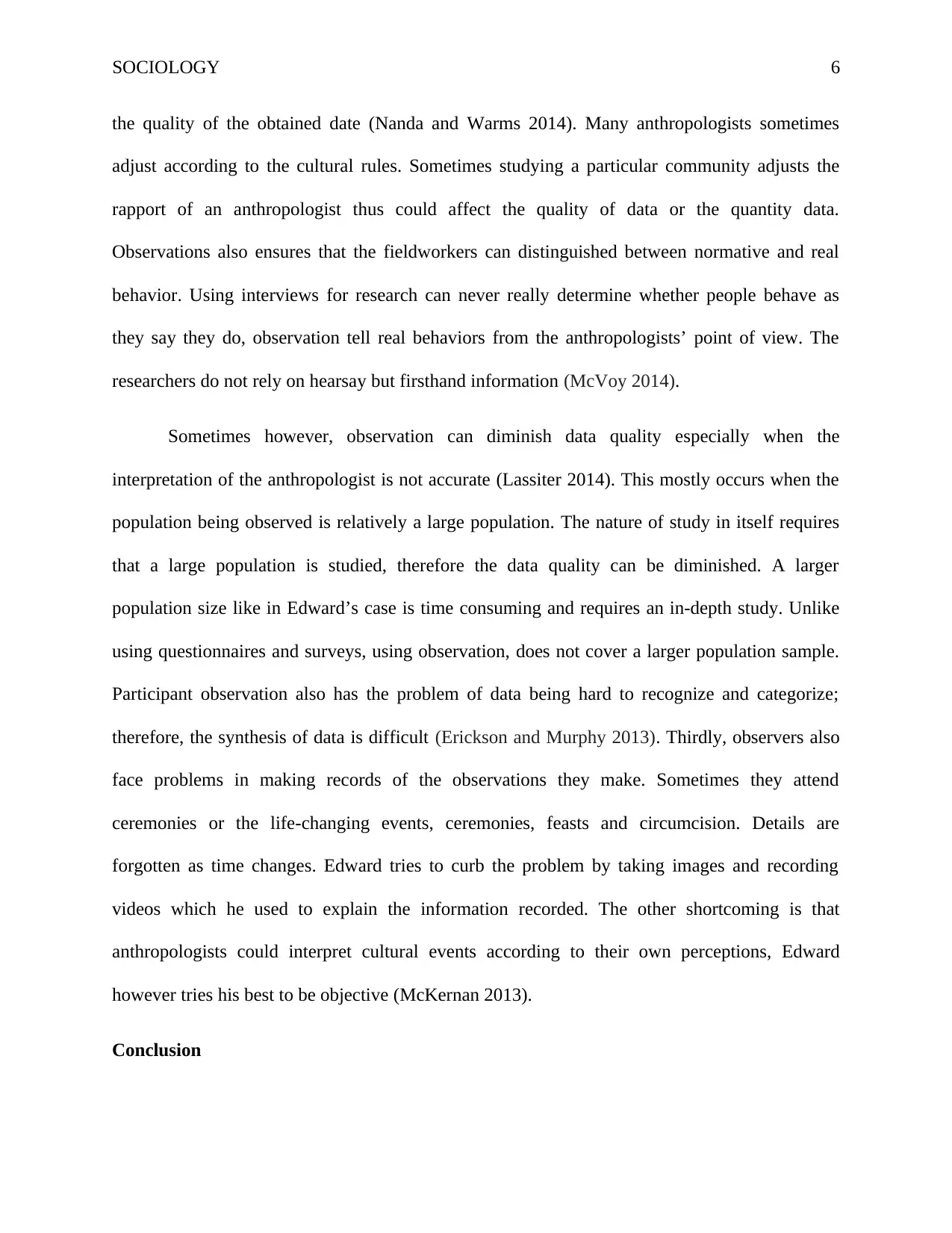
SOCIOLOGY 6
the quality of the obtained date (Nanda and Warms 2014). Many anthropologists sometimes
adjust according to the cultural rules. Sometimes studying a particular community adjusts the
rapport of an anthropologist thus could affect the quality of data or the quantity data.
Observations also ensures that the fieldworkers can distinguished between normative and real
behavior. Using interviews for research can never really determine whether people behave as
they say they do, observation tell real behaviors from the anthropologists’ point of view. The
researchers do not rely on hearsay but firsthand information (McVoy 2014).
Sometimes however, observation can diminish data quality especially when the
interpretation of the anthropologist is not accurate (Lassiter 2014). This mostly occurs when the
population being observed is relatively a large population. The nature of study in itself requires
that a large population is studied, therefore the data quality can be diminished. A larger
population size like in Edward’s case is time consuming and requires an in-depth study. Unlike
using questionnaires and surveys, using observation, does not cover a larger population sample.
Participant observation also has the problem of data being hard to recognize and categorize;
therefore, the synthesis of data is difficult (Erickson and Murphy 2013). Thirdly, observers also
face problems in making records of the observations they make. Sometimes they attend
ceremonies or the life-changing events, ceremonies, feasts and circumcision. Details are
forgotten as time changes. Edward tries to curb the problem by taking images and recording
videos which he used to explain the information recorded. The other shortcoming is that
anthropologists could interpret cultural events according to their own perceptions, Edward
however tries his best to be objective (McKernan 2013).
Conclusion
the quality of the obtained date (Nanda and Warms 2014). Many anthropologists sometimes
adjust according to the cultural rules. Sometimes studying a particular community adjusts the
rapport of an anthropologist thus could affect the quality of data or the quantity data.
Observations also ensures that the fieldworkers can distinguished between normative and real
behavior. Using interviews for research can never really determine whether people behave as
they say they do, observation tell real behaviors from the anthropologists’ point of view. The
researchers do not rely on hearsay but firsthand information (McVoy 2014).
Sometimes however, observation can diminish data quality especially when the
interpretation of the anthropologist is not accurate (Lassiter 2014). This mostly occurs when the
population being observed is relatively a large population. The nature of study in itself requires
that a large population is studied, therefore the data quality can be diminished. A larger
population size like in Edward’s case is time consuming and requires an in-depth study. Unlike
using questionnaires and surveys, using observation, does not cover a larger population sample.
Participant observation also has the problem of data being hard to recognize and categorize;
therefore, the synthesis of data is difficult (Erickson and Murphy 2013). Thirdly, observers also
face problems in making records of the observations they make. Sometimes they attend
ceremonies or the life-changing events, ceremonies, feasts and circumcision. Details are
forgotten as time changes. Edward tries to curb the problem by taking images and recording
videos which he used to explain the information recorded. The other shortcoming is that
anthropologists could interpret cultural events according to their own perceptions, Edward
however tries his best to be objective (McKernan 2013).
Conclusion
⊘ This is a preview!⊘
Do you want full access?
Subscribe today to unlock all pages.

Trusted by 1+ million students worldwide
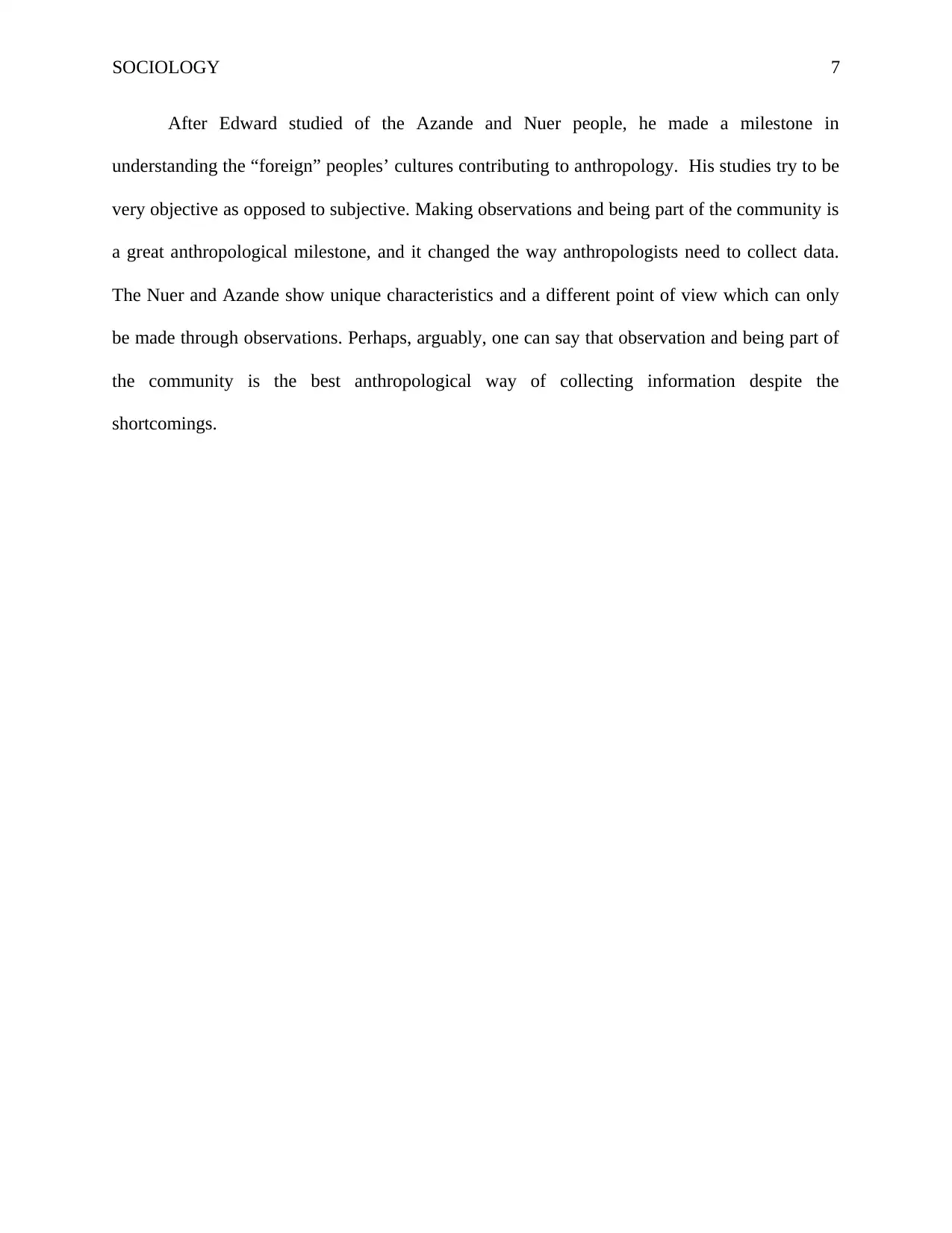
SOCIOLOGY 7
After Edward studied of the Azande and Nuer people, he made a milestone in
understanding the “foreign” peoples’ cultures contributing to anthropology. His studies try to be
very objective as opposed to subjective. Making observations and being part of the community is
a great anthropological milestone, and it changed the way anthropologists need to collect data.
The Nuer and Azande show unique characteristics and a different point of view which can only
be made through observations. Perhaps, arguably, one can say that observation and being part of
the community is the best anthropological way of collecting information despite the
shortcomings.
After Edward studied of the Azande and Nuer people, he made a milestone in
understanding the “foreign” peoples’ cultures contributing to anthropology. His studies try to be
very objective as opposed to subjective. Making observations and being part of the community is
a great anthropological milestone, and it changed the way anthropologists need to collect data.
The Nuer and Azande show unique characteristics and a different point of view which can only
be made through observations. Perhaps, arguably, one can say that observation and being part of
the community is the best anthropological way of collecting information despite the
shortcomings.
Paraphrase This Document
Need a fresh take? Get an instant paraphrase of this document with our AI Paraphraser
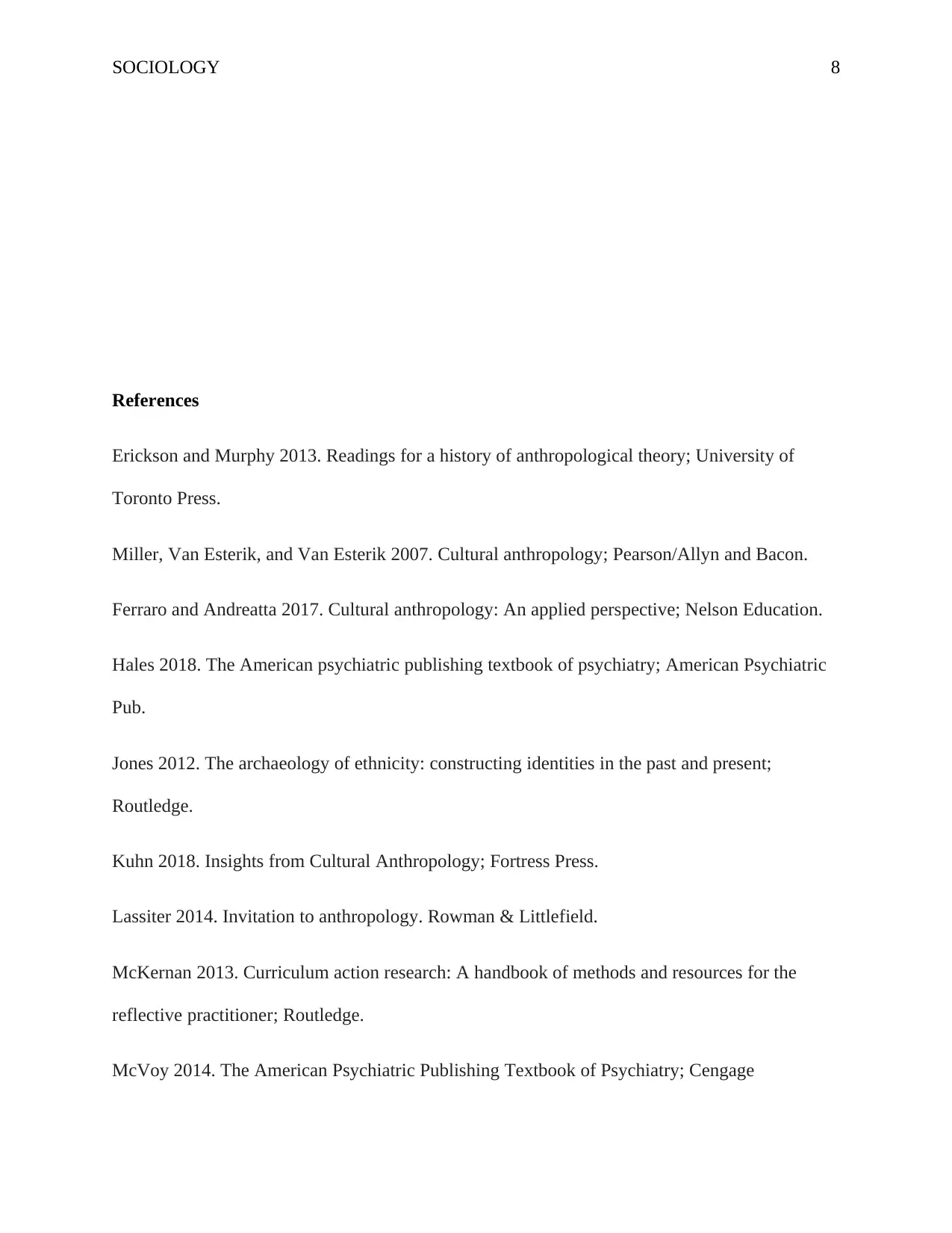
SOCIOLOGY 8
References
Erickson and Murphy 2013. Readings for a history of anthropological theory; University of
Toronto Press.
Miller, Van Esterik, and Van Esterik 2007. Cultural anthropology; Pearson/Allyn and Bacon.
Ferraro and Andreatta 2017. Cultural anthropology: An applied perspective; Nelson Education.
Hales 2018. The American psychiatric publishing textbook of psychiatry; American Psychiatric
Pub.
Jones 2012. The archaeology of ethnicity: constructing identities in the past and present;
Routledge.
Kuhn 2018. Insights from Cultural Anthropology; Fortress Press.
Lassiter 2014. Invitation to anthropology. Rowman & Littlefield.
McKernan 2013. Curriculum action research: A handbook of methods and resources for the
reflective practitioner; Routledge.
McVoy 2014. The American Psychiatric Publishing Textbook of Psychiatry; Cengage
References
Erickson and Murphy 2013. Readings for a history of anthropological theory; University of
Toronto Press.
Miller, Van Esterik, and Van Esterik 2007. Cultural anthropology; Pearson/Allyn and Bacon.
Ferraro and Andreatta 2017. Cultural anthropology: An applied perspective; Nelson Education.
Hales 2018. The American psychiatric publishing textbook of psychiatry; American Psychiatric
Pub.
Jones 2012. The archaeology of ethnicity: constructing identities in the past and present;
Routledge.
Kuhn 2018. Insights from Cultural Anthropology; Fortress Press.
Lassiter 2014. Invitation to anthropology. Rowman & Littlefield.
McKernan 2013. Curriculum action research: A handbook of methods and resources for the
reflective practitioner; Routledge.
McVoy 2014. The American Psychiatric Publishing Textbook of Psychiatry; Cengage
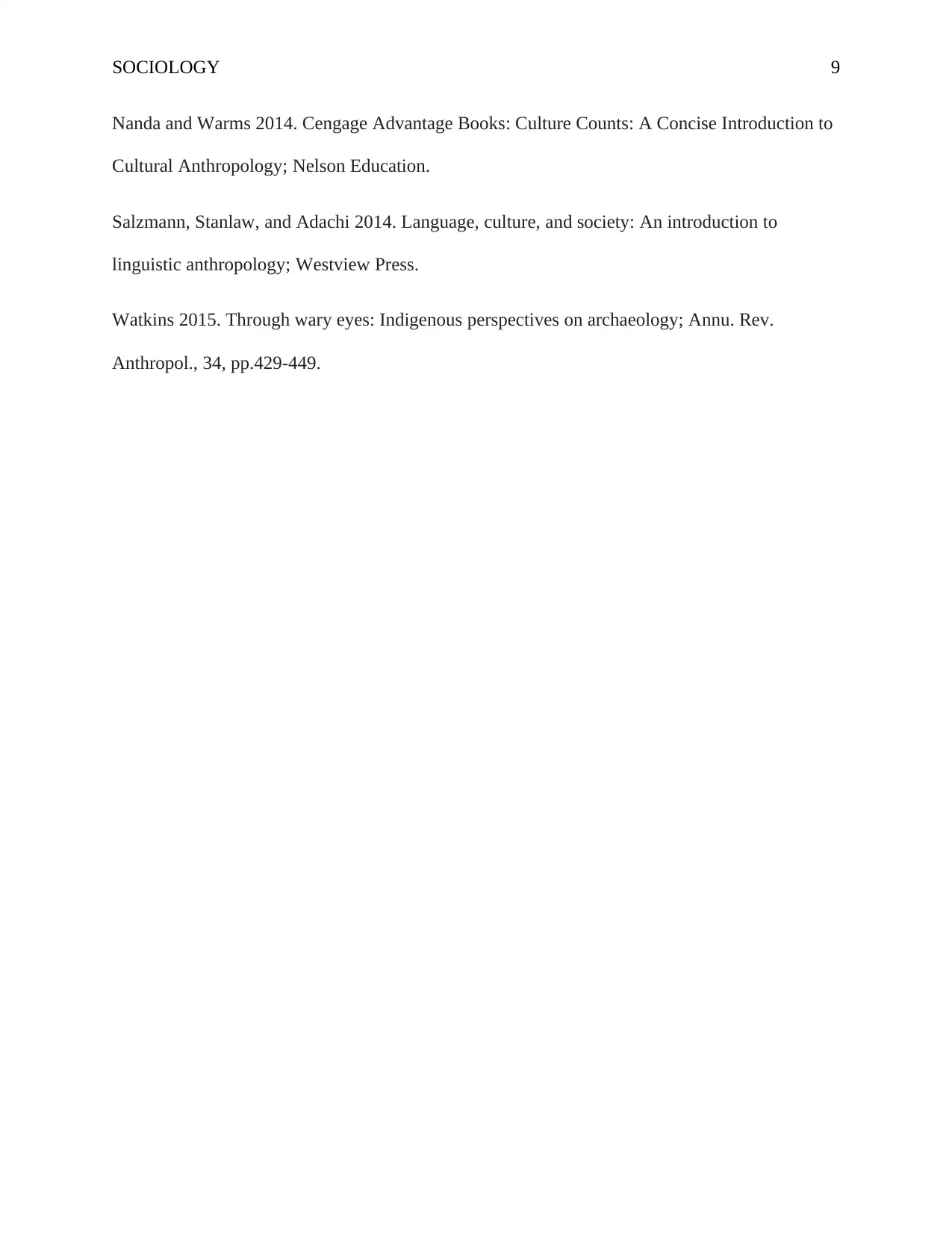
SOCIOLOGY 9
Nanda and Warms 2014. Cengage Advantage Books: Culture Counts: A Concise Introduction to
Cultural Anthropology; Nelson Education.
Salzmann, Stanlaw, and Adachi 2014. Language, culture, and society: An introduction to
linguistic anthropology; Westview Press.
Watkins 2015. Through wary eyes: Indigenous perspectives on archaeology; Annu. Rev.
Anthropol., 34, pp.429-449.
Nanda and Warms 2014. Cengage Advantage Books: Culture Counts: A Concise Introduction to
Cultural Anthropology; Nelson Education.
Salzmann, Stanlaw, and Adachi 2014. Language, culture, and society: An introduction to
linguistic anthropology; Westview Press.
Watkins 2015. Through wary eyes: Indigenous perspectives on archaeology; Annu. Rev.
Anthropol., 34, pp.429-449.
⊘ This is a preview!⊘
Do you want full access?
Subscribe today to unlock all pages.

Trusted by 1+ million students worldwide
1 out of 9
Your All-in-One AI-Powered Toolkit for Academic Success.
+13062052269
info@desklib.com
Available 24*7 on WhatsApp / Email
![[object Object]](/_next/static/media/star-bottom.7253800d.svg)
Unlock your academic potential
Copyright © 2020–2025 A2Z Services. All Rights Reserved. Developed and managed by ZUCOL.
